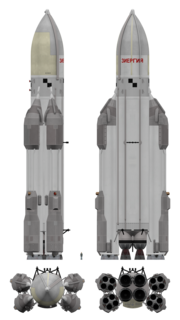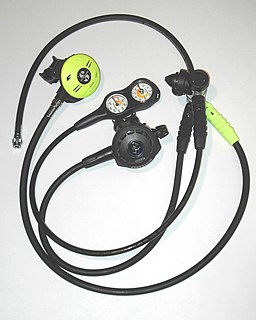
Energia was a super-heavy lift launch vehicle. It was designed by NPO Energia of the Soviet Union for a variety of payloads including the Buran spacecraft. Control system main developer enterprise was the Khartron NPO "Electropribor". The Energia used four strap-on boosters each powered by a four-chamber RD-170 engine burning kerosene/LOX, and a central core stage with four single-chamber RD-0120 (11D122) engines fueled by liquid hydrogen/LOX.
Acts of parliament, sometimes referred to as primary legislation, are texts of law passed by the legislative body of a jurisdiction. In most countries, acts of parliament begin as a bill, which the legislature votes on. Depending on the structure of government, this text may then by subject to assent or approval from the executive branch.

Coal Chamber was an American nu metal band formed by Dez Fafara and Meegs Rascón in Los Angeles, California in 1993. Prior to Coal Chamber, the two had also created the band She's in Pain, in 1992. Coal Chamber disbanded in 2003 after ten years together, and then reunited from 2011 to 2016. The band's first drummer, Jon Tor, was eventually replaced by Mike Cox. After bass guitarist Rayna Foss joined, the Coal Chamber lineup was complete. They released their debut album, Coal Chamber, in 1997. Chamber Music followed two years later. Their third album, Dark Days, was released in the spring of 2002. The only single from the album was "Fiend". Coal Chamber released one more album, Rivals, in 2015, before disbanding again in 2018.

Soyuz is a family of Soviet expendable launch systems developed by OKB-1 and manufactured by Progress Rocket Space Centre in Samara, Russia. With over 1,700 flights since its debut in 1966, the Soyuz is the most frequently used launch vehicle in the world.

An air compressor is a pneumatic device that converts power into potential energy stored in pressurized air. By one of several methods, an air compressor forces more and more air into a storage tank, increasing the pressure. When the tank's pressure reaches its engineered upper limit, the air compressor shuts off. The compressed air, then, is held in the tank until called into use. The energy contained in the compressed air can be used for a variety of applications, utilizing the kinetic energy of the air as it is released and the tank depressurizes. When tank pressure reaches its lower limit, the air compressor turns on again and re-pressurizes the tank. An air Compressor must be differentiated from a pump because it works for any gas/air, while pumps work on a liquid.

A rocket engine uses stored rocket propellants as the reaction mass for forming a high-speed propulsive jet of fluid, usually high-temperature gas. Rocket engines are reaction engines, producing thrust by ejecting mass rearward, in accordance with Newton's third law. Most rocket engines use the combustion of reactive chemicals to supply the necessary energy, but non-combusting forms such as cold gas thrusters and nuclear thermal rockets also exist. Vehicles propelled by rocket engines are commonly called rockets. Rocket vehicles carry their own oxidizer, unlike most combustion engines, so rocket engines can be used in a vacuum to propel spacecraft and ballistic missiles.

A diving regulator is a pressure regulator that controls the pressure of breathing gas for diving. The most commonly recognised application is to reduce pressurized breathing gas to ambient pressure and deliver it to the diver, but there are also other types of gas pressure regulator used for diving applications. The gas may be air or one of a variety of specially blended breathing gases. The gas may be supplied from a scuba cylinder carried by the diver or via a hose from a compressor or high-pressure storage cylinders at the surface in surface-supplied diving. A gas pressure regulator has one or more valves in series which reduce pressure from the source, and use the downstream pressure as feedback to control the delivered pressure, or the upstream pressure as feedback to prevent excessive flow rates, lowering the pressure at each stage.

A liquid-propellant rocket or liquid rocket utilizes a rocket engine that uses liquid propellants. Liquids are desirable because they have a reasonably high density and high specific impulse (Isp). This allows the volume of the propellant tanks to be relatively low. It is also possible to use lightweight centrifugal turbopumps to pump the rocket propellant from the tanks into the combustion chamber, which means that the propellants can be kept under low pressure. This permits the use of low-mass propellant tanks that do not need to resist the high pressures needed to store significant amounts of gases, resulting in a low mass ratio for the rocket.

The J-2 was a liquid-fuel cryogenic rocket engine used on NASA's Saturn IB and Saturn V launch vehicles. Built in the U.S. by Rocketdyne, the J-2 burned cryogenic liquid hydrogen (LH2) and liquid oxygen (LOX) propellants, with each engine producing 1,033.1 kN (232,250 lbf) of thrust in vacuum. The engine's preliminary design dates back to recommendations of the 1959 Silverstein Committee. Rocketdyne won approval to develop the J-2 in June 1960 and the first flight, AS-201, occurred on 26 February 1966. The J-2 underwent several minor upgrades over its operational history to improve the engine's performance, with two major upgrade programs, the de Laval nozzle-type J-2S and aerospike-type J-2T, which were cancelled after the conclusion of the Apollo program.

The staged combustion cycle is a power cycle of a bipropellant rocket engine. In the staged combustion cycle, propellant flows through multiple combustion chambers, and is thus combusted in stages. The main advantage relative to other rocket engine power cycles is high fuel efficiency, measured through specific impulse, while its main disadvantage is engineering complexity.

A trigger is a mechanism that actuates the function of a ranged weapon such as a firearm, airgun, crossbow or speargun. The word may also be used to describe a switch that initiates the operation of other non-shooting devices such as a trap, a power tool or a quick release. A small amount of energy applied to the trigger leads to the release of much more energy.

The HM7B is a European cryogenic upper stage rocket engine used on the vehicles in the Ariane rocket family. It will be replaced by Vinci, which will act as the new upper stage engine on Ariane 6. Nearly 300 engines have been produced to date.
RD-270 (Russian: Раке́тный дви́гатель 270, Rocket Engine 270, 8D420) was a single-chamber liquid-bipropellant rocket engine designed by Energomash (USSR) in 1960–1970. It was to be used on the first stages of proposed heavy-lift UR-700 and UR-900 rocket families, as well as on the N1. It has the highest thrust among single-chamber engines of the USSR, 640 metric tons at the surface of Earth. The propellants used are unsymmetrical dimethylhydrazine (UDMH) and nitrogen tetroxide (N2O4). The chamber pressure was among the highest considered, being about 26 MPa. This was achieved by applying full-flow staged combustion cycle for all the incoming mass of fuel, which is turned into a gas and passes through a couple of turbines before being burned in the combustion chamber. This allowed the engine to achieve a specific impulse of 301 s (2.95 km/s) at the Earth's surface.

The Armstrong Siddeley, later Bristol SiddeleyGamma was a family of rocket engines used in British rocketry, including the Black Knight and Black Arrow launch vehicles. They burned kerosene fuel and hydrogen peroxide. Their construction was based on a common combustion chamber design, used either singly or in clusters of up to eight.
The TR-201 or TR201 is a hypergolic pressure-fed rocket engine used to propel the upper stage of the Delta rocket, referred to as Delta-P, from 1972 to 1988. The rocket engine uses Aerozine 50 as fuel, and N
2O
4 as oxidizer. It was developed in early 1970s by TRW as a derivative of the lunar module descent engine (LMDE). This engine used a pintle injector first invented by Gerard W. Elverum Jr. and developed by TRW in late 1950s and received US Patent in 1972. This injector technology and design is also used on SpaceX Merlin engines.
Heterohelix is an extinct genus of foraminifera belonging to the family Heterohelicidae of the superfamily Heterohelicoidea and the suborder Globigerinina. Its type species is Heterohelix americana.
Heterohelicidae is a family of foraminifera belonging to the superfamily Heterohelicoidea and the suborder Globigerinina.

A built-in breathing system is a source of breathing gas installed in a confined space where an alternative to the ambient gas may be required for medical treatment, emergency use, or to minimise a hazard. They are found in diving chambers, hyperbaric treatment chambers, and submarines.

The SpaceX Raptor is a full-flow staged combustion, methane-fueled rocket engine manufactured by SpaceX. The engine is powered by cryogenic liquid methane and liquid oxygen (LOX), rather than the RP-1 kerosene and LOX used in SpaceX's prior Merlin and Kestrel rocket engines. The earliest concepts for Raptor considered liquid hydrogen as fuel rather than methane. The Raptor engine has more than twice the thrust of the Merlin 1D engine that powers the current Falcon 9 launch vehicle.
The mechanism of diving regulators is the arrangement of components and function of gas pressure regulators used in the systems which supply breathing gases for underwater diving. Both free-flow and demand regulators use mechanical feedback of the downstream pressure to control the opening of a valve which controls gas flow from the upstream, high-pressure side, to the downstream, low-pressure side of each stage. Flow capacity must be sufficient to allow the downstream pressure to be maintained at maximum demand, and sensitivity must be appropriate to deliver maximum required flow rate with a small variation in downstream pressure, and for a large variation in supply pressure, without instability of flow. Open circuit scuba regulators must also deliver against a variable ambient pressure. They must be robust and reliable, as they are life-support equipment which must function in the relatively hostile seawater environment, and the human interface must be comfortable over periods of several hours.













